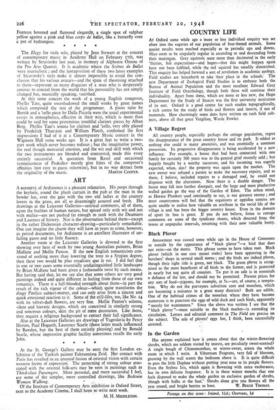ART
A ROOMFUL of Ardizzones is a pleasant relaxation. His peeps through the keyhole, round the plush curtain in the pub at the man in the bowler hat, over the gate with the two old ladies at the country lovers in the grass, are all so disarmingly assured and fresh. His drawings at the Leicester Galleries—satirical comments, all of them, upon the frailties of human nature, but spiced only with wit and not with malice—are not pushed far enough to rank with the Daumiers and Lautrecs of history. Nor is the observation behind them—except in the rather Dickensian character-drawing—particularly remarkable: One can imagine the charm they will have in years to come, however, as period documents, for Ardizzone is an excellent illustrator of un- failing gusto and no little fluency.
Another room at the Leicester Galleries is devoted to the first showing over here of work by two young Australian painters, Brian Midlane and Mollie Paxton. If the new English romanticism con- sisted of nothing more than lowering the tone to a Stygian degree, then these two would be plus royalistes que le roi. I did feel that in one or two cases some essentially undistinguished little landscapes by Brian Midlane had been given a fashionable twist by such means. But having said that, let me say also that some others are very good paintings indeed and quite different in feeling from those of our own romantics. There is a full-blooded strength about them—in part the result of the rich vigour of the colour—which quite transforms the dingy Pimlico subject-matter, and can only arise from a sincere and quick emotional reaction to it. Some of the still-lifes, too, like No. 24 with its velvet-dark flowers, are very fine. Mollie Paxton's solemn, silent and hieratic designs, which are conceived in similarly strong and sonorous colours, skirt the pit of mire decoration. Like ikons, they require a religious background to extract their full significance.
Also at the Leicester Galleries are drawings of Yugoslavia by Percy Horton, Paul Hogarth, Laurence Scarfe (these latter much influenced by Bawden, but the best of them entirely pleasing) and by Ronald Searle, whose impressive graphic facility sometimes recalls the early John. * * * * At the St. George's Gallery may be •seen the first London ex- hibition of the Turkish painter Fahrunnissa Zeid. Her contact with Paris has resulted in an unusual fusion ot.oriental vision with certain western forms of expression: The patterning of strong colour asso- ciated with the oriental folk-arts may be seen in paintings such as Third-class Passengers. More personal, and more successful I feel, are some of the simpler, more controlled drawings, like Bedouin Women Walking. • Of the Institute of Contemporary Arts exhibition in Oxford Street, next to the Academy Cinema, I shall hope to write next week.
M. H. MIDDLEroist.






























 Previous page
Previous page